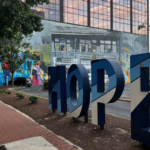Cape Town, South Africa, is one of the most stunning places I have visited. The landscape is unforgettable: mountains, blue waves, pristine beaches, rich soil.
Juxtaposed to the beauty of the land, however, are townships that are an ugly reminder of the past.
I visited Khayelitsha Township in Cape Town, and it was like time stood still.
The world has heard of the end of apartheid. We have heard of the political ascendancy of the African National Congress and of the election of Nelson Mandela and several of his successors to the presidency.
We have heard about a “New South Africa,” and this makes it all the more astonishing to see the poor, unsanitary living conditions of the black Africans in the townships.
They are living in tiny shacks put together with scrap metal. The roofs of these homes usually leak during the rainy season, so it may be days before inhabitants get to sleep on something dry.
There are also communal bathrooms that the government built throughout the township; one toilet is shared by many homes.
There are water pumps throughout the township, so the people have to go out of their shacks to get water.
The townships that exist today give the impression that apartheid has never been dismantled.
Then we ask ourselves: How is it possible that such an evil system has been eliminated, yet millions of black Africans live in unfathomable conditions?
How is it possible, this mistreatment of people of color because of our own preconceived notions of who others are?
The black Africans lived in South Africa first, and it was the Dutch and the English who came over and colonized the country.
The power that the few white people can have over people of color (especially when backed by force of arms) is astounding.
Unfortunately, this process of discrimination is partially rooted within Christianity, and with the ways in which religions develop and maintain the status quo.
Furthermore, the small percentage of black Africans who have gained power and money have in some ways contributed to maintaining the status quo.
This is the unfortunate nature of humanity, which fails to recognize the necessity to change the system so that all and not only a few are liberated.
From a religious point of view, the racism and prejudice that exist in Christianity can be associated with a particular strain of Dutch Calvinism.
The Afrikaners contended that God had made a special covenant with them, one that essentially gave them a “Promised Land” and excluded the indigenous population.
The distortion of Christianity here is the pretension that God has specially elected a particular ethnic or racial group at the expense of others – something that Calvin himself would have found incomprehensible.
This grave misinterpretation of Christianity came into place within our Christian thinking and psyche to confirm and reconfirm racism within religion and Christianity.
Thus, Calvinism is one example of it, and there are many other examples of racism that have been imbedded into religion to make it appear as some divine doctrine that all followers must abide by (e.g., some people can be saved, others cannot; people who make money are saved, those who don’t, aren’t).
This type of Christian doctrine and belief is outrageous and in certain ways, the church calls this progress. This is mindless and lacks reverence.
However, this is endemic within our whole culture. If we do not do anything about it, then we are the problem. If we sit around and do nothing, we are just making it worse.
We see injustice within our society, culture and in our churches. The question is: How do we eliminate this oppression and achieve justice?
We are all part of the community of creation. Shalom needs to be let loose, and we need to restore the world and work toward justice.
Grace Ji-Sun Kim is associate professor of doctrinal theology at Moravian Theological Seminary.




